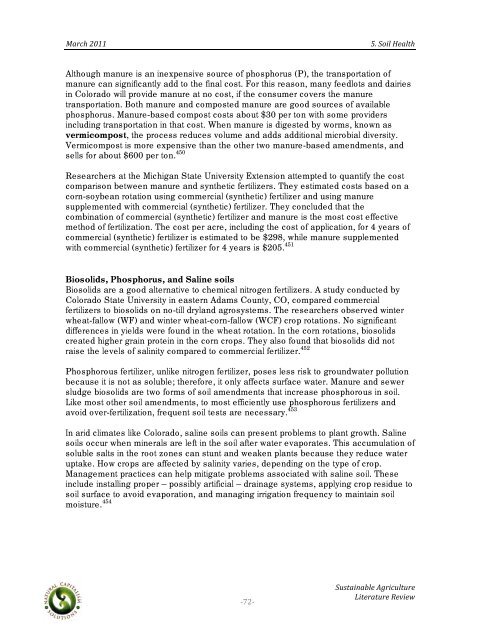Sustainable Agriculture Literature Review - Boulder County
Sustainable Agriculture Literature Review - Boulder County
Sustainable Agriculture Literature Review - Boulder County
Create successful ePaper yourself
Turn your PDF publications into a flip-book with our unique Google optimized e-Paper software.
! !!<br />
"#$%&!'())!! !!!!!!!!!!!!!!!!!!!!!!!!!!!!!!!!!!!!!!!!!!!!!!!!!!!!!!!!!!!!!!!!!!!!!!!!!*+!,-./!01#/2&!<br />
Although manure is an inexpensive source of phosphorus (P), the transportation of<br />
manure can significantly add to the final cost. For this reason, many feedlots and dairies<br />
in Colorado will provide manure at no cost, if the consumer covers the manure<br />
transportation. Both manure and composted manure are good sources of available<br />
phosphorus. Manure-based compost costs about $30 per ton with some providers<br />
including transportation in that cost. When manure is digested by worms, known as<br />
vermicompost, the process reduces volume and adds additional microbial diversity.<br />
Vermicompost is more expensive than the other two manure-based amendments, and<br />
sells for about $600 per ton. 450<br />
Researchers at the Michigan State University Extension attempted to quantify the cost<br />
comparison between manure and synthetic fertilizers. They estimated costs based on a<br />
corn-soybean rotation using commercial (synthetic) fertilizer and using manure<br />
supplemented with commercial (synthetic) fertilizer. They concluded that the<br />
combination of commercial (synthetic) fertilizer and manure is the most cost effective<br />
method of fertilization. The cost per acre, including the cost of application, for 4 years of<br />
commercial (synthetic) fertilizer is estimated to be $298, while manure supplemented<br />
with commercial (synthetic) fertilizer for 4 years is $205. 451<br />
Biosolids, Phosphorus, and Saline soils<br />
Biosolids are a good alternative to chemical nitrogen fertilizers. A study conducted by<br />
Colorado State University in eastern Adams <strong>County</strong>, CO, compared commercial<br />
fertilizers to biosolids on no-till dryland agrosystems. The researchers observed winter<br />
wheat-fallow (WF) and winter wheat-corn-fallow (WCF) crop rotations. No significant<br />
differences in yields were found in the wheat rotation. In the corn rotations, biosolids<br />
created higher grain protein in the corn crops. They also found that biosolids did not<br />
raise the levels of salinity compared to commercial fertilizer. 452<br />
Phosphorous fertilizer, unlike nitrogen fertilizer, poses less risk to groundwater pollution<br />
because it is not as soluble; therefore, it only affects surface water. Manure and sewer<br />
sludge biosolids are two forms of soil amendments that increase phosphorous in soil.<br />
Like most other soil amendments, to most efficiently use phosphorous fertilizers and<br />
avoid over-fertilization, frequent soil tests are necessary. 453<br />
In arid climates like Colorado, saline soils can present problems to plant growth. Saline<br />
soils occur when minerals are left in the soil after water evaporates. This accumulation of<br />
soluble salts in the root zones can stunt and weaken plants because they reduce water<br />
uptake. How crops are affected by salinity varies, depending on the type of crop.<br />
Management practices can help mitigate problems associated with saline soil. These<br />
include installing proper – possibly artificial – drainage systems, applying crop residue to<br />
soil surface to avoid evaporation, and managing irrigation frequency to maintain soil<br />
moisture. 454<br />
!<br />
"+("<br />
!,342#.5#6/1!78$.%3/23$1!<br />
9.21$#23$1!:1;.1
















